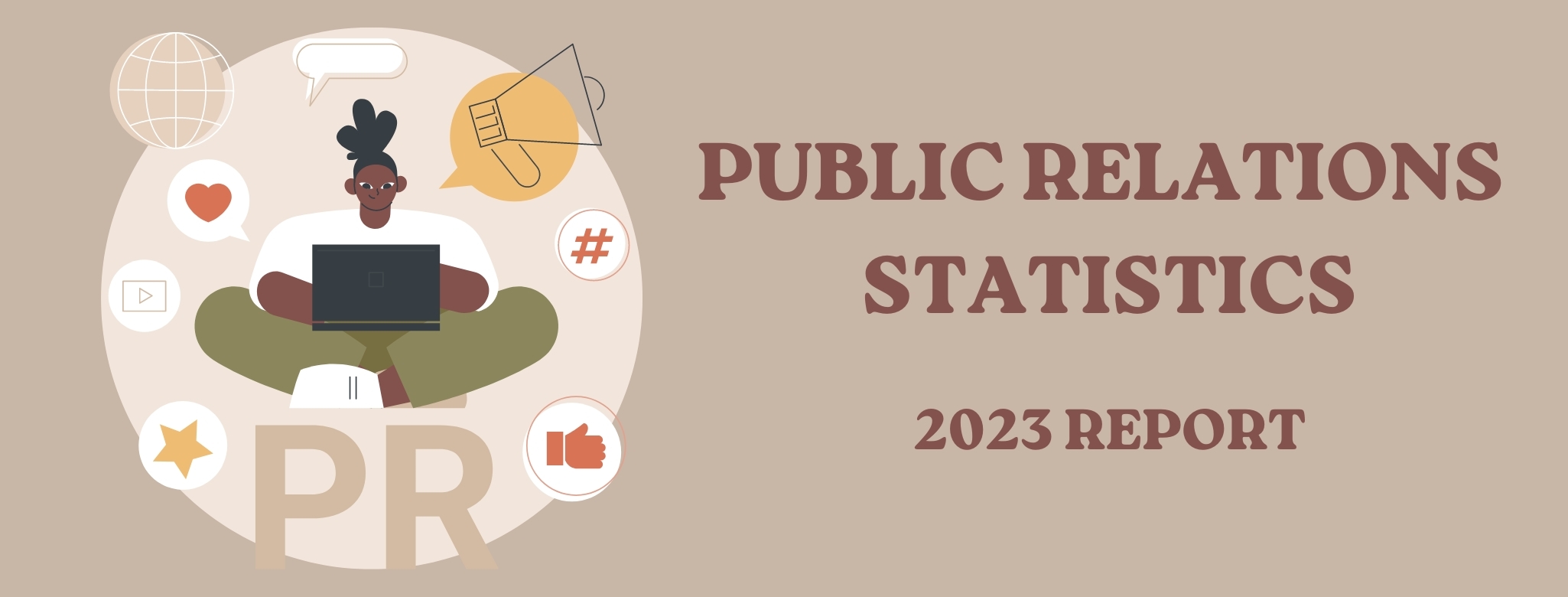
12 May TOP PUBLIC RELATIONS STATISTICS IN 2023
Public relations (PR) continues to play a crucial role in the branding, popularity, and credibility efforts of a firm! The global PR market reached over $21.6 billion in 2022, and still growing in 2023, with the United States accounting for the largest share of this market at $10.1 billion. This scale of the global PR market is further supported by the number of people working in the area of communications; as of 2021 there are 58,000 people working in the industry. In 2021, the average salary of the PR specialist is $119,000. The industry continues to be dominated by the female workforce, and 73% of the PR managers are women. Press releases are still ranked as some of the most trustworthy channels in media with 42% of surveyed people saying they are the most credible source of news.
Below, we highlight 15 key public relations statistics:
Public Relation Statistics (Editors Choice)
- The PR industry employs over 58,000 people in the U.S.
- In 2021, the average salary of a PR specialist was $119,000
- Around 73% of PR specialists are women
- 42% of people trust press releases over other media channels
- 93% of PR specialists compose pitches that are 300 words or less
- A single press release costs between $400 and $2000
Public Relations: 15 Top Public Relations Statistics in 2023!
Public Relations Statistics #1: As of 2021, the global PR market is worth 97 billion U.S. dollars.
According to the latest report by Statista, the global PR market is worth 97 billion U.S. dollars as of 2021. This is a significant increase from the 88 billion U.S. dollars that the industry was worth in 2020. The trend is expected to continue, with the industry surpassing a value of 129 billion dollars by the end of 2025. This growth can be attributed to a number of factors, including the increasing importance of online communication and the evolving landscape of the media industry. As companies become more reliant on digital channels to reach their audiences, PR firms are experiencing increased demand for their services. At the same time, traditional media outlets are facing declining revenues, creating opportunities for PR firms to fill the void. As a result, the global PR market is poised for significant growth in the coming years.

Public Relations Statistics #2: the U.S. PR agencies generated a total revenue of 14.54 billion U.S. dollars in 2021.
According to data from Statista, the U.S. public relations agencies generated total revenue of 14.54 billion U.S. dollars in 2021, which is a significant increase from 14.07 billion in 2020. The PR industry establishments were on track to surpass 15 billion dollars in revenue. Despite the coronavirus outbreak, the revenues still grew, albeit slower and not reaching 15 billion yet. This can be attributed to the fact that many companies have realized the importance of investing in PR during difficult times to maintain a good image and relationship with the public. As we reach the end of 2022, it will be interesting to see if the industry can bounce back and get the 15 billion mark.
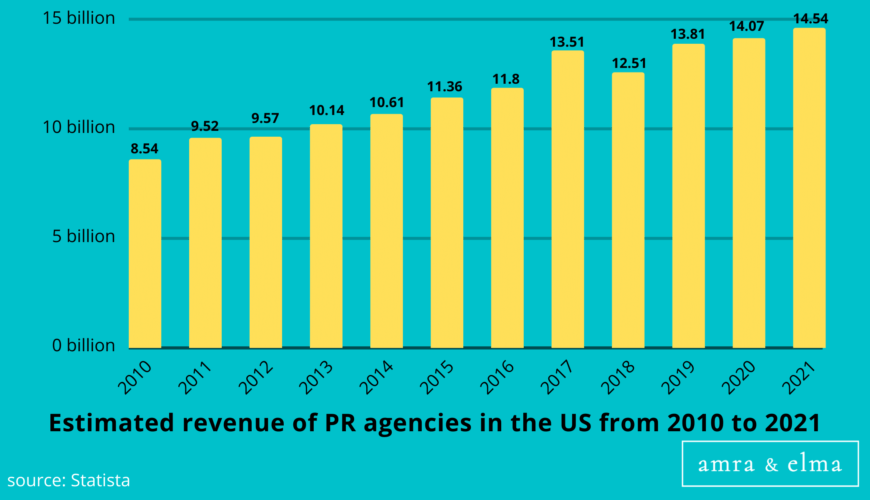
Public Relations Statistics #3: Full PR agency’s services revenue in the U.S. was more than 9.6 billion U.S. dollars in 2021.
According to statistics from Statista, the full PR agency’s services revenue in the U.S. was more than 9.6 billion U.S. dollars in 2021. Based on the annual data provided by the Census on the revenues of public relations firms in the United States, it was found that PR agencies in the country generated 697 million U.S. dollars with media relations services in 2021. Full public relations services brought in more than 9.6 billion U.S. dollars that year for these companies. The majority of this revenue came from services such as branding and identity, crisis management, and digital marketing. These numbers show a continued growth trend for the PR industry, which is expected to continue in the coming years.

Public Relations Statistics #4: the U.S. public relations agencies spent a total of 11.5 billion U.S. dollars in 2021.
Statista’s Census on estimated expenses of companies in different sectors annually released data shows that in 2021, the U.S. public relations agencies spent a total of 11.5 billion U.S. dollars. Firms in this industry surpassed expenses of 10 billion dollars for the first time in 2016. These agencies play an important role in creating and maintaining the public image of their clients, and the increase in spending indicates that businesses are willing to invest more in their reputation management. With the continue growth of social media and the 24-hour news cycle, it is essential for businesses to have a strong public relations strategy in place in order to protect their brand and ensure that they are presenting themselves in the best light possible.
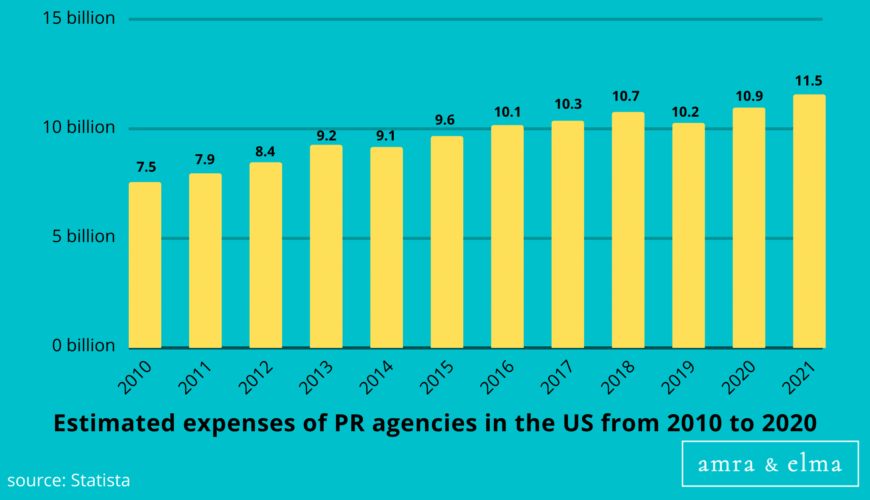
Public Relations Statistics #5: As of 2021, there are 8505 establishments specializing in public relations services in the United States.
Statista reports that as of 2021, there are 8505 thousand establishments specializing in public relations services in the United States. This number has not changed much from 8317 in 2013, but it spiked from 7728 back in 2007. The industry employs over 300 thousand people and generates roughly $16 billion in revenue annually. Most public relations firms are small businesses with ten or fewer employees. The industry is concentrated in large metropolitan areas such as New York City, Los Angeles, and Chicago. The vast majority of firms offer generalist services, but there is a growing trend of firms specializing in particular industries or niches. With the advent of social media, the public relations industry has undergone a significant transformation. Traditional media relations are still important, but more and more firms are focused on digital strategies such as online content marketing and influencer outreach.

Public Relations Statistics #6: As of 2021, more than 58 thousand people work at U.S. public relations agencies.
A recent report from Statista shows that the number of people employed by public relations agencies in the United States has been steadily increasing in recent years. In 2014, there were 53,752 people working in the industry, and by 2016, that number had grown to 58,489. This trend appears to be continuing, with Statista predicting that the number of PR agency employees will reach 59 thousand people by the end of 2022. The steady growth of the PR industry is good news for those seeking a career in communications. It demonstrates that businesses are increasingly valuing the importance of effective communication with their stakeholders. As the industry continues to grow, there will be more opportunities for talented individuals to make a name for themselves in the world of public relations.
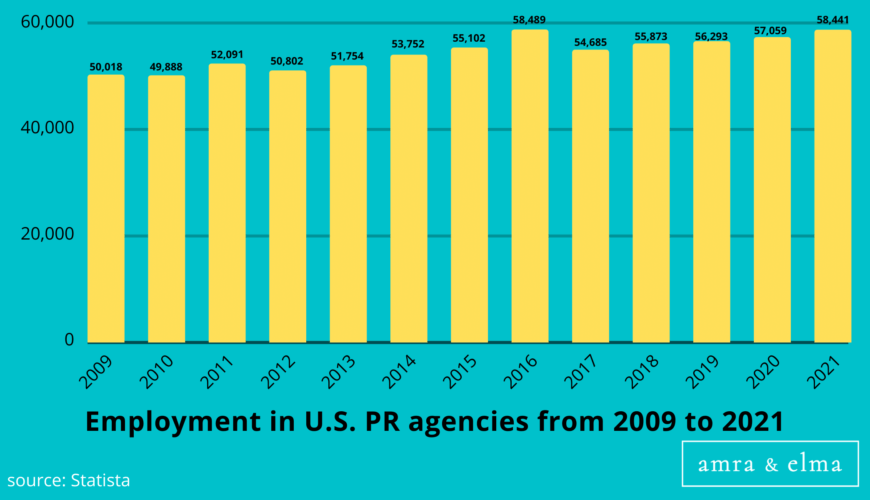
Public Relations Statistics #7: In 2021, the average salary in the public relations sector in North America amounted to nearly 119.6 thousand U.S. dollars.
Statista.com reports that in 2021, the average salary in the public relations sector in North America amounted to nearly 119.6 thousand U.S. dollars. This is a significant increase from the 102.5 thousand reported in 2020, and the 96 thousand reported in 2019. The public relations sector is crucial for businesses and organizations, as it helps to manage and protect their reputation. The COVID-19 pandemic has highlighted the importance of good PR, as businesses have had to navigate difficult challenges such as supply chain disruptions and employee layoffs. Those who work in public relations must be able to think creatively and adapt to changing circumstances quickly. As the world continues to grapple with the pandemic, the demand for skilled PR professionals is likely to continue to grow.
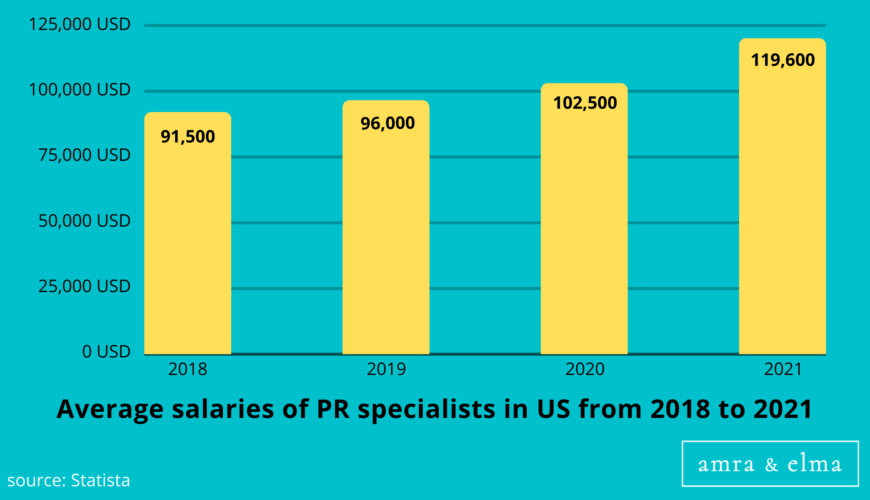
Public Relations Statistics #8: Almost 73% of PR managers are female.
Statista’s report on the gender distribution in public relations industry in 2021 shows that almost 73% of the positions account to females. This is a significant increase from previous year, where women only made up about 60% of the workforce. The ladies seem to be taking over the public relations industry, as these statistics show. Women account for 73% of overall PR job positions. This increase can be attributed to the growing number of women entering the field, as well as the advancement of others within the industry. With more women than ever before taking on leadership roles in public relations, it is clear that this is an industry that is welcoming and supportive of female talent.
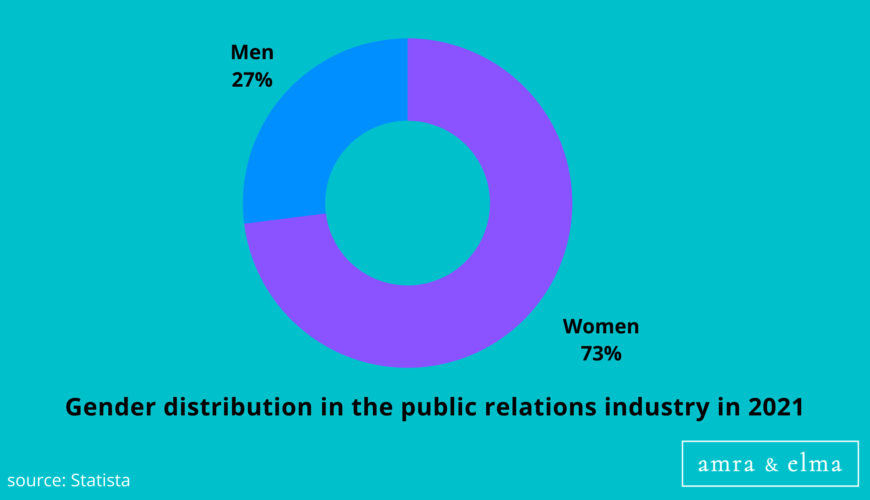
Public Relations Statistics #9: Press releases are ranked as the most trustworthy channel for media.
According to Cision’s research report, people have low trust in news sources in general, and media professionals are no exception. Traditional forms of PR like well crafted press releases, however, still stand strong, and with 42%, are ranked as the most trustworthy source by media in the US. They outrank company websites (21%), blogs (4%), social media (4%), and spokespeople (29%). The study also found that media professionals consider press releases to be more trustworthy when they come from external sources, such as independent organizations or NGOs. This is likely due to the perception that these sources are less biased than companies or other institutions. In light of this, it is clear that press releases can be an effective way to communicate with the media, provided that they are coming from a trusted source.

Public Relations Statistics #10: Email is the most popular communication tool among PR professionals.
According to the latest Muck Rack’s public relations statistics, emails are still the most commonly used tool among PR professionals, with direct messaging, phone, and video conferencing software coming in second, third, and fourth place. This is likely due to the fact that email is a quick and easy way to get in touch with someone, and it also allows for a written record of the conversation. However, it’s important to remember that not everyone responds to emails immediately, so it’s essential to be patient when waiting for a response. In addition, phone and video conferencing can be a great way to build relationships with journalists and other media professionals. PR professionals can establish rapport and better understand their needs and wants by using these tools.

Public Relations Statistics #11: About 94% of PR pros write pitches under 300 words.
Muck Rack conducted a study and found that 94% of PR professionals said their average pitch length is under 300 words – a stat that aligns with the 91% of journalists interviewed who said they prefer pitches under 300 words. While there is no hard-and-fast rule for pitch length, the vast majority of PR pros and journalists agree that shorter pitches are more effective. This doesn’t mean that every pitch should be just a few words long, but it’s important to focus on the most important points and make them as clear as possible. A well-written, well-timed pitch can be the key to success in the competitive world of public relations. So when you’re crafting your next pitch, remember that less is often more.
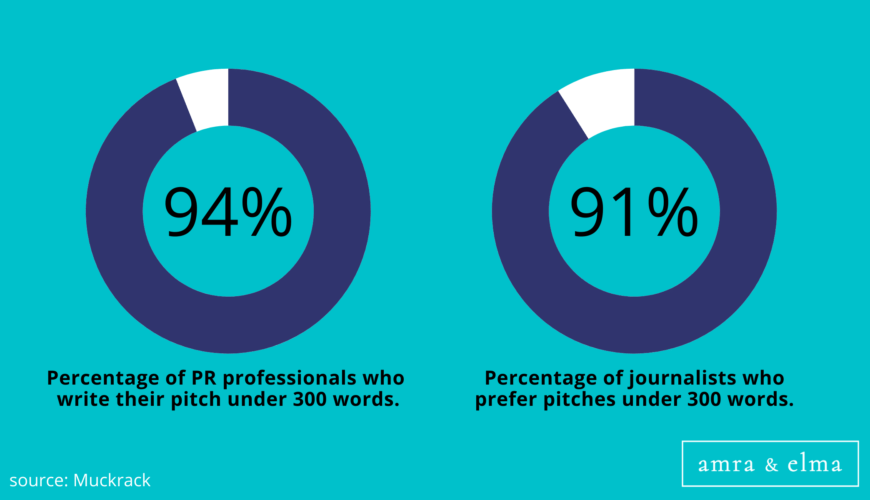
Public Relations Statistics #12: A single press release can cost anywhere from $400 to $2,000.
According to Prowly, one of the well-known public relations facts is that you have to be ready to pay the price, whether you want an eloquent public relations strategy or an articulate single press release. For example, Business Wire, one of the leading press release distribution companies, charges $830 for 400 words and $230 for each additional 100 words. While this may seem like a lot of money, it is essential to remember that a well-crafted press release can significantly impact your business. In addition, distributing your press release through a reputable company like Business Wire guarantees that a broad audience will see your release of potential customers. As a result, the cost of a press release is worth the investment if you are serious about promoting your business.
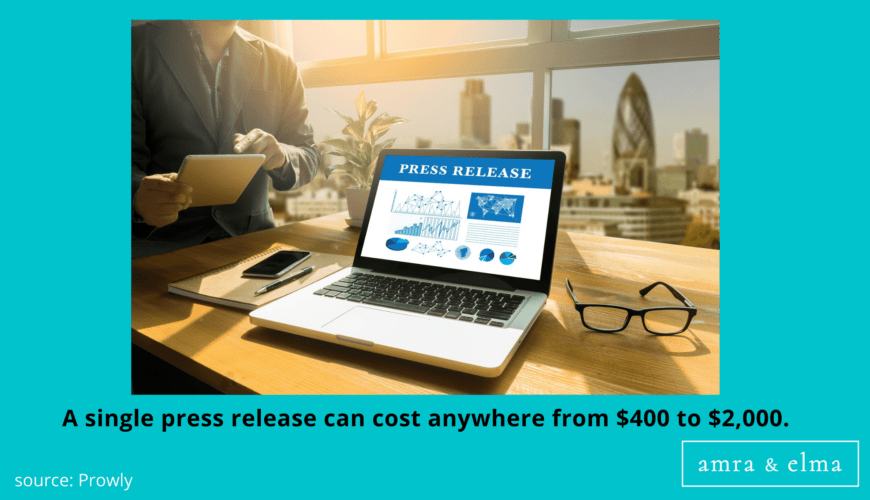
Public Relations Statistics #13: 45% of PR specialists report to the CMO.
According to the latest Sword and the Script report, most PR specialists (45%) report to the CMO. Also, many of them report directly to the CEO (33%). Public relations jobs statistics further show that the remainder answer to the COO (8%), strategy (6%), human resources (5%), and legal (3%). In reality, the situation should be different. When polled about whom they should report to, the majority of 71% stated CEO. Alternatively, only 24% chose CMO and 4% COO. This discrepancy may be due to a lack of understanding about the role of PR or a misunderstanding of its objectives. Whatever the reason, it’s clear that there’s a disconnect between how PR professionals want to be organized and how they’re structured within their organizations. As PR continues to evolve and broaden its scope, this issue must be addressed so that PR can be placed in a position to best contribute to organizational success.
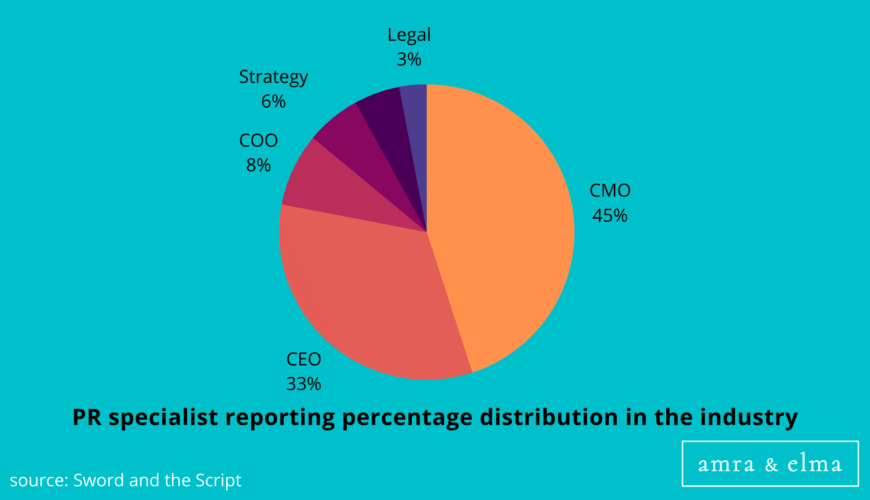
Public Relations Statistics #14: 85% of PR professionals say morning is the best time to send a pitch, and 64% of journalists also said they preferred morning pitches.
According to Muck Rack’s media pitching statistics, 85% of PR professionals say morning is the best time to send a pitch, and 64% of journalists also said they preferred morning pitches. Evening pitches are wildly unpopular, with just 4% of journalists expressing this preference. This is because mornings are when most people are fresh and have the most energy, making it the ideal time to send a pitch. Journalists are often inundated with emails, so getting your pitch in early can help ensure it’s seen. However, there’s no harm in doing some research to see if the journalist you’re pitching prefers a different time of day – after all, they’re the experts.
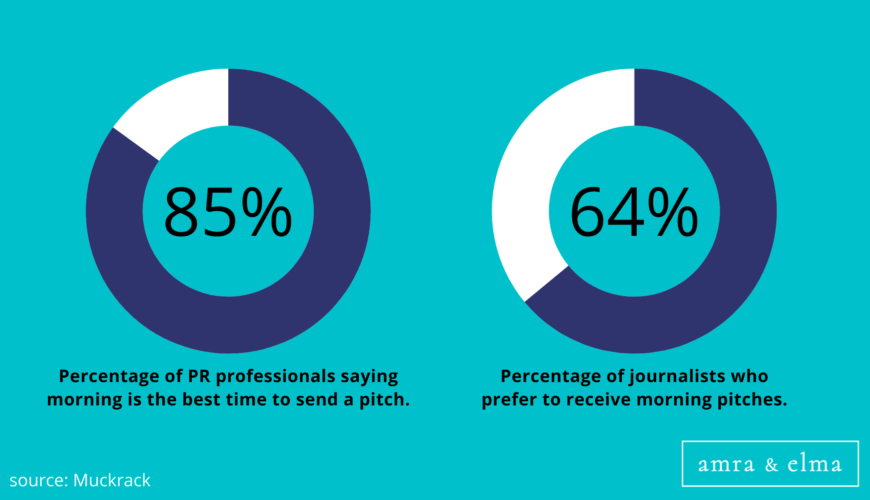
Public Relations Statistics #15: 45% of PR professionals said that Tuesday is the best day to send a pitch.
According to the latest Muck Rack’s media pitching statistics, 45% of PR professionals said that Tuesday is the best day to send a pitch. But among the dates journalists preferred, Monday was still the most popular choice (20%), with only 10% saying Tuesday. The reasoning behind this preference is that Monday is the start of the workweek, which gives journalists more time to go through their pitches and assignments. Tuesday is often considered to be too late in the week, as many journalists are already swamped with work and may not have time to go through new pitches. However, there are exceptions to every rule, and there are always going to be days when journalists are more likely to respond to pitches. Ultimately, it’s up to the PR professional to know their audience and pitch accordingly.

The Future of Public Relations Statistics
After going through some of the essential PR statistics and trends in public relations, it is safe to say that PR plays an important role in building businesses’ success. These essential PR statistics and trends gave us a snapshot of the current public relations landscape. They show us where the industry is booming and where it might need a little help. By understanding these statistics, we can better tailor our PR strategies to meet the needs of the public. Additionally, these statistics can help identify new opportunities for growth in the industry. As the public relations landscape continues to evolve, these essential statistics and trends will continue to provide valuable insights in years to come.
Does PR have a future?
PR has a future because the future of public relations is the future of your business. As long as the media landscape keeps changing, public relations will also have to adapt to ensure brand relevance and longevity.
Is PR a growing field?
PR is a growing field – Employment of public relations specialists is projected to grow 11 percent from 2020 to 2030, faster than the average for all occupations. About 29,200 openings for public relations specialists are projected each year, on average, over the decade.
How is PR evolving?
PR is evolving through Social media, which has been a massive factor in the modern evolution of PR, with many businesses not knowing how to take it on. Public relations professionals have adapted, learning to navigate these new platforms to their advantage by strategizing how to manage, create and post content.
What are the latest trends in PR?
The latest trends in PR include the following:
- Align your purpose with an ethical audience.
- Focus on engagement, not promotion, on social media.
- Air your words on podcasts.
- Make space for more visuals.
- Shift toward micro- and nano-influencers.
- Measure your efforts with data.
- Collaborate with other brands.
Who is a public relations specialist?
Public relations specialist is responsible for managing the public image of their clients. Public relations specialist works to build and maintain positive relationships between their clients and the public. Public relations specialist uses a variety of methods to achieve this, including media relations, social media, and branding.
They could also be in charge of writing the content for websites and other marketing collateral like brochures. In some cases, a public relations specialist may even be involved in crisis management. Public relations specialist must have excellent communication skills and be able to think on their feet. They must also be able to handle stress well, as they often deal with difficult situations.
Public relations specialist typically has a degree in communications or a related field. They may also have experience in marketing or journalism.
Why is a public relations specialist important?
Public relations specialist is important because they are the bridge between an organization and the public. An organization’s success depends on its ability to effectively communicate with the public. Public relations specialist helps to build and maintain positive relationships with key stakeholders, including customers, employees, shareholders, partners, and the community. A successful public relations specialist uses various communication channels to share an organization’s story, messages, and news. Public relations specialist also works to protect and enhance an organization’s image by managing its reputation.
Effective public relations specialist can help an organization achieve its business goals by increasing awareness of its products or services, shaping public opinion, and building goodwill. They can also help an organization respond to crises and navigate complex situations. By communicating with the public clearly and consistently, public relations specialist plays a critical role in creating a strong relationship between an organization and its stakeholders.
What does a public relations specialist do?
A public relations specialist, or PR specialist, is a communications professional who helps organizations build positive relationships with the public. They do this by creating and implementing communication plans that promote the organization’s image and objectives.
To achieve this, public relations specialist typically has a deep understanding of the media landscape and how to best reach different audiences. They also have strong writing and editing skills, as well as experience crafting effective messaging.
In addition to working with the media, public relations specialist may also be responsible for developing and managing social media campaigns, writing speeches or articles for executives, and organizing events or press conferences.
Overall, public relations specialist plays a critical role in shaping an organization’s image and helping it achieve its communications goals.
How to find the best public relations specialist?
When it comes to finding a public relations specialist, there are a few key things to keep in mind. First and foremost, it’s important to find public relations specialist with experience in your specific industry. As with any profession, public relations has its lingo and insider knowledge that can be difficult to learn without hands-on experience.
That’s why it’s also important to find a public relations specialist who is familiar with your company and its products or services. They should understand your unique selling points and be able to communicate them effectively to the media and other key audiences.
Finally, you’ll want to find public relations specialist who is a good fit for your company culture. Public relations specialist often acts as the face of the company, so they must mesh well with your team.
With those factors in mind, here are a few tips on how to find the best public relations specialist:
- Ask around. Chances are, you know someone who knows someone who knows a public relations specialist. Request recommendations and referrals from your network.
- Do your research on the best public relations specialist. Once you have a list of potential candidates, do some digging online to learn more about their experience and client list.
- Interview candidates. Once you’ve narrowed down your list, schedule interviews with each candidate to find the best public relations specialist, and ask them questions about their experience, approach to PR, and what they think would be the best strategy for your company.
- Make a decision. After weighing all the information, make a decision about which candidate is the best fit for your company, and you’ll find your best-fit public relations specialist.
How do public relations agencies operate?
Public relations agencies are businesses, and as such, they have a variety of expenses that need to be paid to keep the lights on and the doors open. To generate income, public relations agencies typically charge their clients a monthly retainer fee. This fee can range from a few hundred dollars to several thousand dollars, depending on the size and scope of the agency.
In addition to the monthly retainer fee, public relations agencies also bill their clients for services rendered. These services can include things like writing press releases, developing marketing materials, arranging interviews or media appearances, and creating social media campaigns. The cost for each of these services will vary depending on the rates of public relations agencies and the amount of work that needs to be done.
Public relations agencies also earn income by selling advertising space in their newsletters, brochures, or website. And finally, many public relations agencies receive a commission when one of their clients is featured in the news or secures a major contract.
How to find the best public relations agencies?
There are a few steps that you can take to find the best public relations agencies for your needs. The first step is to make a list of the things that are important to you in public relations agencies. Some factors of public relations agencies that you may want to consider include the size of the agency, the areas of expertise they have, their client base, and their fees.
Once you have a list of factors that are important to you, you can start researching specific public relations agencies. One way to do this is by looking at rankings or reviews of public relations agencies. Many different websites and publications compile rankings and reviews of public relations agencies, like Amra&Elma, so you should be able to find one that is relevant to your needs.
Another way to research public relations agencies is by contacting them directly and asking for information about their services. This will give you a chance to get a feel for public relations agencies and see if they would be a good fit for your needs.
Finally, once you have narrowed down your list of potential public relations agencies, it is important to contact them and set up meetings so that you can get a better idea of what they offer. This will help you make the final decision about which of the public relations agencies is right for you.
What are some of the most effective public relations strategies?
Public relations strategies refer to the methods used by organizations and individuals to inform the public of their message, product, or service. Public relations strategies are often employed to build relationships with stakeholders, boost visibility, create positive customer experiences, and maintain a good reputation. The most effective public relations strategies can be divided into two categories: traditional and digital.
Traditional public relations strategies involve print media such as press releases, newspapers, magazines, television advertisements, radio spots, and outdoor advertising. These public relations strategies are used to reach a broad audience quickly and provide credibility for the product or service being promoted. Press releases are one of the oldest forms of public relations strategies and remain an effective tool for getting information out quickly and efficiently. Additionally, press releases as one of the best public relations strategies can be used to generate news coverage in publications that would otherwise not report on a business or story.
Digital public relations strategies such as social media campaigns, website optimization, and content marketing are also effective ways to spread a message or story. Social media is another part of public relations strategies that provides an excellent platform for engaging with target audiences in real-time while content marketing provides valuable educational materials that can help attract potential customers.
What type of public relations strategies do brands need the most?
Public relations strategies are an integral part of any modern brand’s marketing plan. As the face of the company, public relations strategies play a vital role in helping convey and protect brands from competition, negative press, and customer concerns. With the ever-changing landscape of media and technology, there are various public relations strategies that brands can employ to strengthen their public relations efforts.
Other types of public relations strategies that are especially effective include reputation management and similar tactics. This part of public relations strategies involves monitoring online conversations about a brand and responding appropriately to any criticisms or negative feedback. Reputation management is also a part of public relations strategies, and also requires proactive efforts to create positive associations with a brand by promoting its best qualities through social media posts, press releases, reviews, interviews, and other types of content.
Another important consideration when developing public relations strategies is thought leadership marketing. Through white papers, blog posts, speeches, webinars, and other forms of content marketing that focus on industry trends or topics related to a brand’s offerings, companies can use these public relations strategies to position themselves as thought leaders in their respective fields while strengthening their reputations among customers and prospects alike.
Finally, crisis communication is one of the crucial types of public relations strategies, and should always be part of any comprehensive public relations strategy. Companies usually use public relations strategies because they need a plan for responding quickly and effectively when an incident occurs that could harm the company’s reputation or bottom line. This might involve issuing some types of public relations strategies like press releases addressing the issue head-on or working with media outlets for damage control purposes after an incident has occurred.

